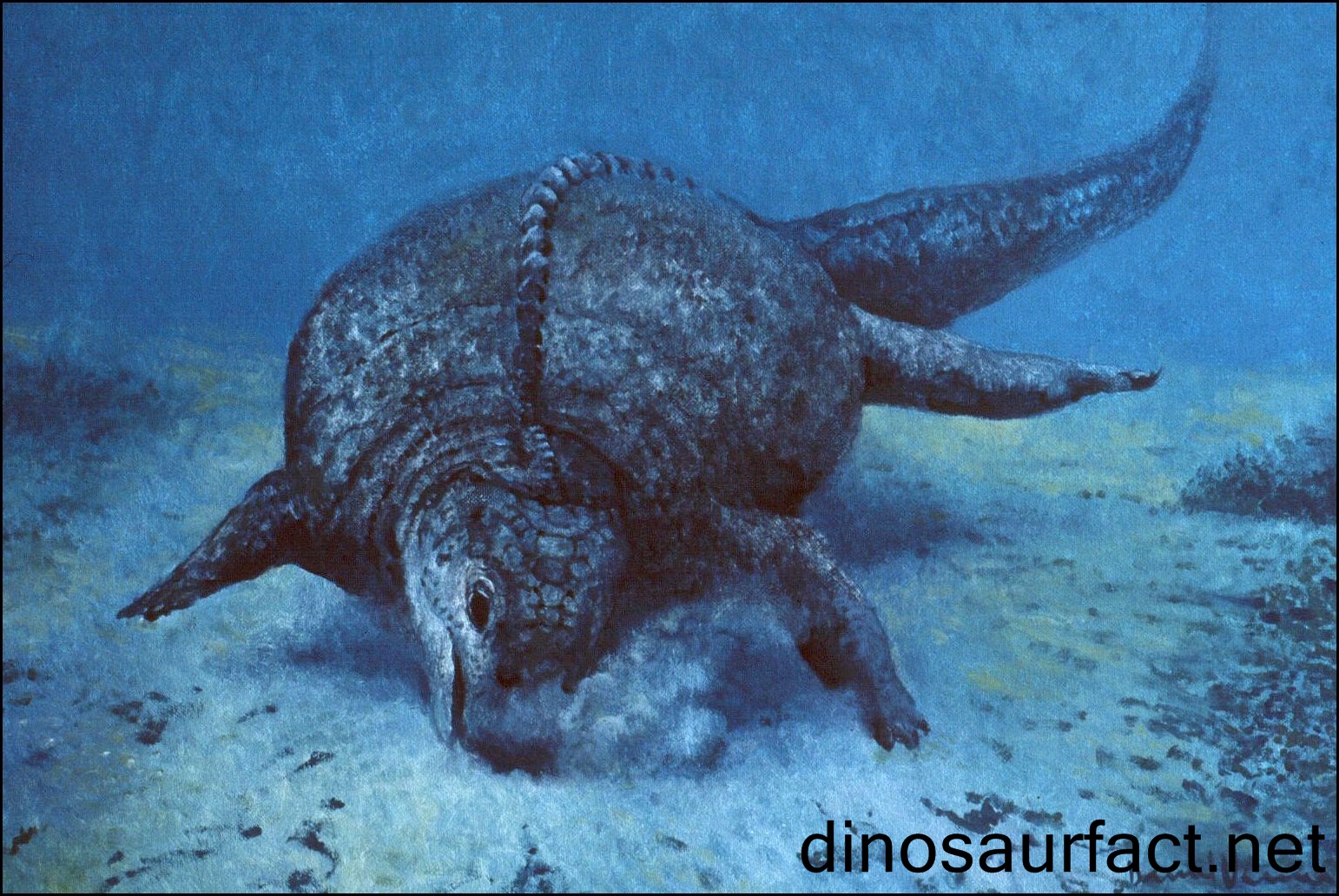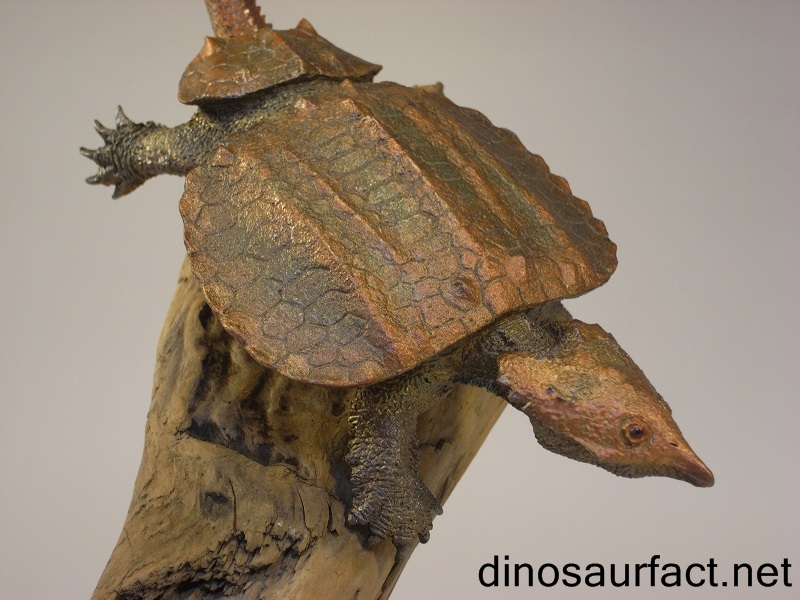 Click to visit the previous Marine Specie bio
Click to visit the previous Marine Specie bio
 |
|
 |
|
Kingdom: Animalia
Phylum: Chordata
Class: Reptilia
SuperOrder: Sauropterygia
Order: Placodontia
Family: Placochelyidae
Genus: Psephoderma
 |
|
 |
|
 |
|

The Psephoderma was a small reptile that existed in the Triassic period. It belonged to order Placodontia, a group which consisted of organisms that looked like turtles. But they were not related to primitive tortoises or turtles.
The time period of its existence is judged to around 230 to 210 million years ago. This lies between the Carnian and Norian ages of the Jurassic period. Placodonts had become extinct by the beginning of the Jurassic period and hence scientists believe that the Psephoderma could have been among the last of the placodonts.
The Psephoderma was about three feet in length. It wasn't a bulky creature and weighed about 5 to 10 kilos. It was intermediate in size as compared to other placodonts.
The exoskeleton of the Psephoderma was different as compared to other placodonts. It had two dorsal shields whereas most other placodonts had only one. This was its distinguishing feature.
Etymology
The Psephoderma is named for the texture of its external shell. ‘Psephos' is the Greek term for ‘gravels’. The suffix 'derma' is derived from the Greek word for 'skin'. Thus the name Psephoderma translates to 'pebble like skin'. Although the no skin specimens have been found with the fossils of the Psephoderma, its shell has been found and it had a bumpy appearance.
The binominal name Psephoderma alpinum was selected for the organism as its fossils were discovered in Italy near the Alpine mountain ranges.
The subspecies P. anglicum was found in the region of Italy inhabited mostly by Englishmen and hence was named accordingly.
The Psephoderma was named by the scientists Christian von Meyer.
Discovery of fossils
- The holotype of the Psephoderma was found in Italy in the late 1850s. It was located in the Triassic quarries of Endenna along the Italian coastline.
- After this discovery, a single paratype was uncovered from Italy itself from the Poscante quarry.
- A few years later, a third set of fossils were excavated in Italy which were attributed to the Psephoderma. These are the only three known specimens of the Psephoderma.
- It is believed to have inhabited the whole of the European continent.
- Most of the Psephoderma fossils consisted of near complete skeletons. The exoskeleton of the P. alpinum was very nicely preserved. Due to this, the morphological characteristics of the Psephoderma are well understood.
Current location of fossils
The three Italian fossils of the Psephoderma are housed in three different museums, namely the Milan Natural History Museum, the Museo di Scienze Naturali Enrico Caffi in Bergamo and The Museum of the Vicar of St. Lawrence in Zogno.
Taxonomic classification
- The Psephoderma is classified under super order Sauropterygia and family Placochelyidae. These groups were not described in the nineteen century and hence Meyer did not comment on the ancestry and relations of the Psephoderma.
- The order Sauropterygia also includes plesiosaurs and Nothosaurs along with placodonts. It is believed that the placodonts became extinct because they were hunted and replaced by their better evolved cousins such as the above mentioned ones.
- Two species are included in genus Psephoderma: P. alpinum and P. anglicum.
- Some scientists believe that the genus Placochelys is synonymous with the Psephoderma, but such views are not accepted in general by the paleontological community.
Christian von Meyer
Christian Erich Hermann von Meyer was a German scientist born in Frankfurt. He had performed extensive research on Triassic and Jurassic dinosaur fossils.
Meyer is credited with describing the primitive sauropod dinosaur Plateosaurus engelhardti.
In his periodical the ‘Paleologica’, he has described the transitional adaptations in the leg bones of vertebrates when migrating from a terrestrial lifestyle to an aquatic lifestyle.
He was the recipient of the Wollaston medal in the year 1858.
Physical characteristics
- The Psephoderma was a small vertebrate growing to a maximum length of about 0.8 to 1 meter. Its weight was around 10 to 25 pounds.
- The physical appearance of the Psephoderma was singular. Its head was tiny and its snout was long.
- The snout was modified to form a beak like projection. This beak was very strong and possessed rounded teeth. It afforded the Psephoderma an extended reach.
- The Psephoderma had flat teeth on its upper and lower jaw which were designed for crushing hard surfaces.
- The dorsal shell or carapace of the Psephoderma was segmented. The upper segment covered its cervical and thoracic region and the lower segment protected its sacral region.
- The Psephoderma lacked a ‘plastron’ or ventral exoskeleton but it possessed ‘gastralia’ or dermal bones.
- The pelvic girdle of the Psephoderma was better developed than its pectoral girdle.
- Its limbs were small; with the hind limbs being longer than the forelimbs.
- The tail of the Psephoderma was stout at the base and tapering towards the end.
Habits and habitat
The Psephoderma was carnivorous. Its diet consisted of shell fish and its cranium was adapted to capture such invertebrates. Its beak was able to reach inside cracks and crevices, locations where shell fish usually resided. Its dentition was such that it could easily penetrate the tough outer covering of crustaceans.
The Psephoderma lived in shallow waters. And it had to look out for predators everywhere in its habitat. If it swam too close to the shore, it would have been attacked by theropod dinosaurs. If it swam too deep in the ocean, it land right in the heart of larger marine predators such as ichthyosaurs and nothosaurs. The nothosaur Lariosaurus was known to eat placodonts; it is believed that placodonts became extinct due to immergence of such larger predators.
Although the fossils of the Psephoderma were only found in Italy, it is believed to have inhabited most parts of Europe.
Related and coexisting species
The Psephoderma was closely related to the placodont Cyamodus and was intimately related to the Placochelys. It is possible that the Psephoderma evolved from the Placodus.
Only a few species of placodonts out-lived the Psephoderma.
Many aquatic vertebrates and invertebrates shared the habitat of the Psephoderma. It could have coexisted with the Lariosaurus and the Ceresiosaurus.
Conclusion
The Psephoderma was one of the last placodonts to be seen on earth. It resembled sea turtles and horseshoe crabs without being related to either. This is an instance of convergent evolution.
Although food was always readily available to the Psephoderma, It could not compete with the larger and better hunters of the Triassic waters. In fact placodonts developed shells to protect themselves from such predators. Unfortunately for the Psephoderma, this adaptation was not very efficacious and it eventually became extinct.
Index
Extinct Profiles
 Triassic Dinosaurs
Triassic Dinosaurs Jurassic Dinosaurs
Jurassic Dinosaurs Cretaceous Dinosaurs
Cretaceous Dinosaurs Pterosaurs
Pterosaurs Marine Reptiles
Marine Reptiles Dinosaur Extinction
Dinosaur Extinction